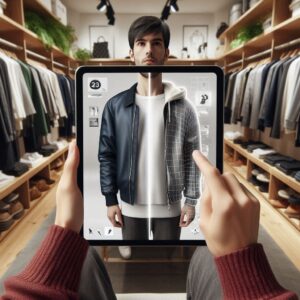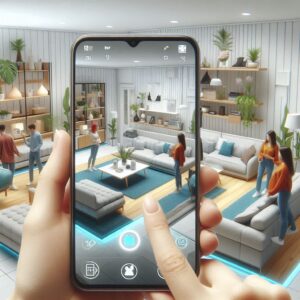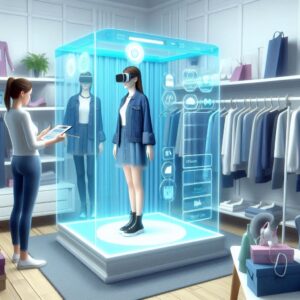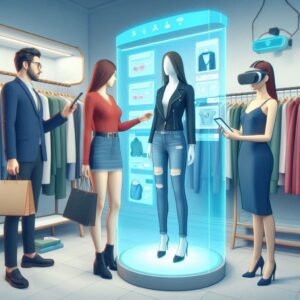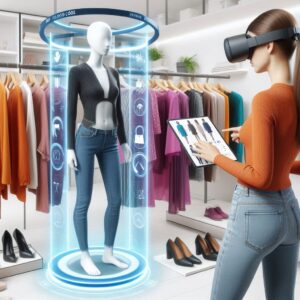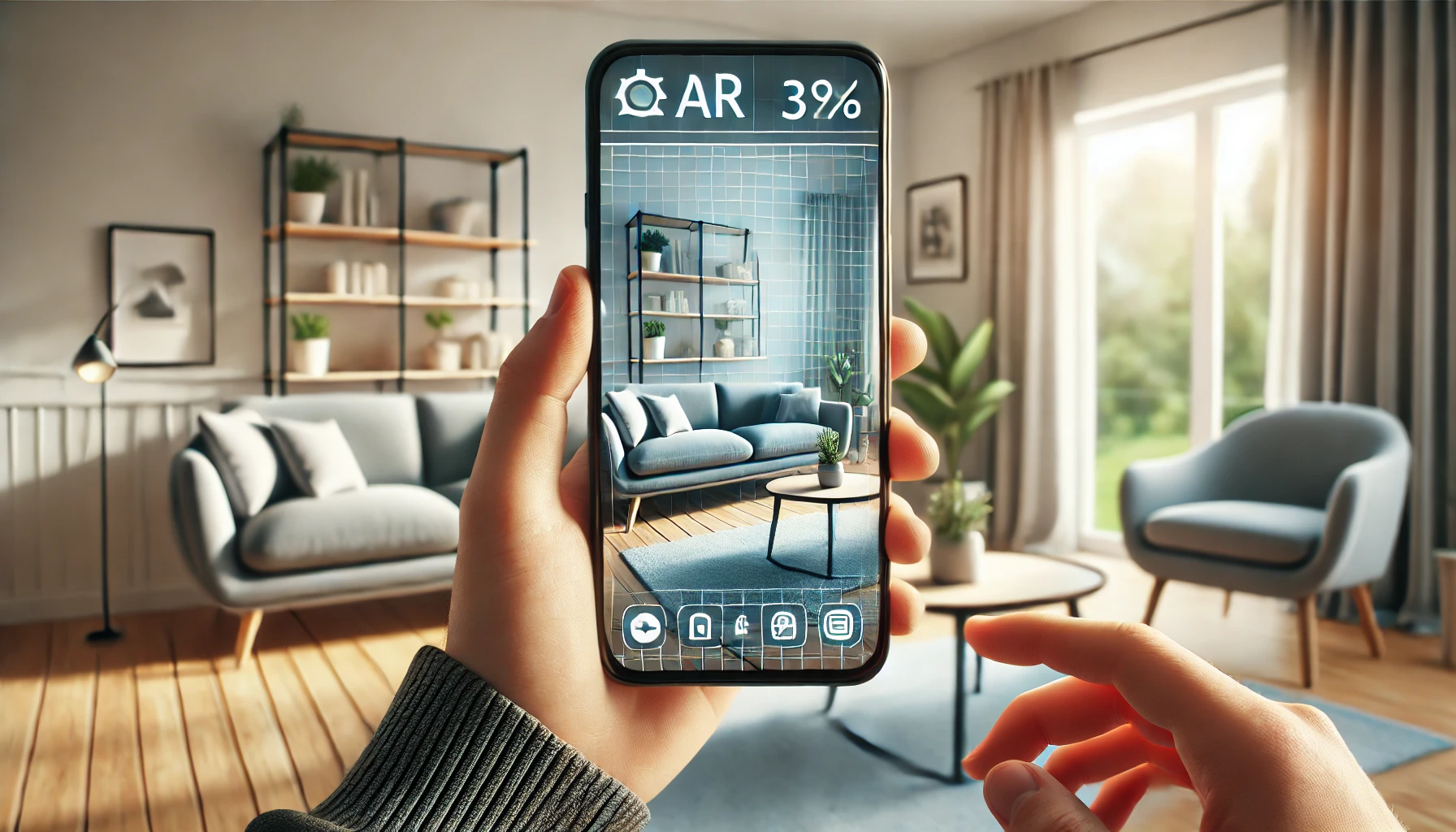
Shopping has transformed dramatically with digital advancements, but augmented reality (AR) may be one of the biggest shifts we’ve seen. By overlaying digital elements onto the real world, AR lets customers visualize products in their space, on their bodies, or even alongside their current possessions—all while shopping from home. The technology bridges the gap between the online and in-store experience, empowering shoppers to make better-informed decisions. But what does the future hold for AR in e-commerce, and how does it compare to its virtual cousin, VR (virtual reality)?
In this post, we’ll dive into the future potential of AR, how it differs from VR, and the pros and cons of using AR in the shopping experience.
How AR and VR Differ in the Shopping Experience
AR and VR are both immersive technologies, but they serve very different purposes in shopping. Augmented reality overlays digital elements onto the real world, blending the physical and digital. For example, with a home decor app, you could view a digital version of a couch in your actual living room. This experience feels grounded and practical, as it enhances the existing environment rather than replacing it.
In contrast, virtual reality (VR) is an entirely immersive experience that requires users to enter a simulated, 3D world, typically using a VR headset. VR transports the user to a different space entirely, which can be advantageous for exploring a fully immersive virtual storefront. However, VR requires more hardware and is less convenient for everyday shopping than AR, which can be accessed via a smartphone.
The Current State and Future Potential of AR in E-Commerce
Right now, AR is making a major impact in fashion, beauty, and home goods, but its potential extends even further. As smartphone cameras, processing power, and AR software evolve, AR in e-commerce is only likely to grow. Here’s what we might expect in the near future:
- Wider Adoption Across Industries
AR has already proven itself in sectors like fashion and beauty. Brands such as Gucci allow customers to try on shoes virtually, while L’Oréal’s app lets users see different hair colors and makeup products on their own faces. Moving forward, we’re likely to see AR expand into new industries, from automotive (for viewing cars in your driveway) to real estate (allowing virtual property walkthroughs). - Increased Realism and Interaction
Current AR technology is impressive, but there’s always room for improvement. Future AR experiences may include even more realistic textures, lighting adjustments based on real-time environments, and options for interacting with AR objects (like opening virtual drawers on a 3D-rendered cabinet). - Integration with AI and Data Personalization
The future of AR will likely incorporate artificial intelligence (AI) to create highly personalized shopping experiences. Imagine an AR app that learns your style preferences and offers tailored product suggestions based on your past choices. AI could also assist in fitting products to exact dimensions, from clothing sizes to room layouts, making AR not only more engaging but also more useful. - Enhanced Social Shopping
Social media is already playing a big role in AR, and in the future, we may see entire virtual showrooms accessible through platforms like Instagram or Snapchat. Imagine sharing an AR try-on of a new outfit directly in your feed or inviting friends into your AR room to offer opinions on furniture selections.
The Pros and Cons of Augmented Reality in E-Commerce
Pros of AR in E-Commerce
- Enhanced Shopping Confidence
One of the greatest benefits of AR is its ability to give shoppers a much clearer sense of what they’re purchasing. Trying on clothes virtually, visualizing furniture in your home, or matching makeup shades to your skin tone helps customers feel confident about their choices, reducing the need for returns. - Reduced Return Rates
With online shopping, returns are notoriously high, and one of the main reasons is the “gap” between what customers see online and what they receive. AR helps bridge that gap, reducing return rates by setting realistic expectations and helping shoppers pick the right item from the start. - Personalized and Interactive Shopping
AR can be customized to the user’s preferences and allow for an interactive shopping experience. Customers have more control over how they view and explore products, leading to a shopping experience that feels tailored to them and their personal style. - Convenience and Accessibility
Unlike VR, which requires specialized equipment, AR is accessible on most smartphones, making it more convenient for the everyday user. As long as you have a phone, you can access AR shopping features from anywhere, whether you’re on the go or at home. - Increased Engagement and Brand Loyalty
Offering an AR experience can make brands memorable and enjoyable to interact with, especially among younger audiences who appreciate tech-savvy brands. Many companies see higher engagement and increased brand loyalty as customers become invested in the immersive experience.
Cons of AR in E-Commerce
- High Development Costs
AR requires specialized technology, from 3D modeling to real-time rendering. For smaller brands, the cost of developing an AR feature can be prohibitive. Large companies may be able to invest in custom AR experiences, but for small businesses, this might mean relying on generic AR platforms that lack customization. - Limited Device Compatibility
While AR is accessible on most modern smartphones, not all devices are capable of handling high-quality AR experiences. For AR to become mainstream, there must be broader compatibility, so all shoppers have access to the same high-quality experience. - User Privacy Concerns
Since AR relies on a smartphone’s camera, many users are wary about privacy. Apps with AR features often need access to cameras and location data, which can raise concerns over data usage and privacy risks. Brands must work hard to address these concerns to maintain customer trust. - Learning Curve for Users
Some users may find AR shopping challenging, especially those who aren’t familiar with newer technologies. For AR to become a universal tool in e-commerce, brands need to make these features intuitive and easy to use for everyone.
Will AR Really Become the Future of Shopping?
Augmented reality’s future in e-commerce looks promising, but it still has some challenges to overcome. As AR technology becomes more accessible, we may see it evolve into a core part of online shopping, especially in sectors where visualization is crucial—like fashion, beauty, and home decor.
However, AR’s long-term success in e-commerce will depend on a few factors. First, the technology must become more accessible and affordable for businesses of all sizes. Smaller brands should be able to develop AR experiences without facing prohibitive costs. Second, privacy and data security must remain a priority as AR technology grows in sophistication. Lastly, as user demand grows, brands will need to make AR features more intuitive, so they’re easy to use for all customers.
For consumers, AR offers a compelling mix of convenience and interaction that’s hard to ignore. In the coming years, AR may not only enhance online shopping—it could redefine it. Imagine a world where AR is as expected and accessible as product photos or reviews, making shopping a fully interactive, engaging experience from start to finish.
Conclusion
AR in e-commerce represents a shift towards an immersive, user-centered approach to shopping. As more brands embrace this technology, the gap between online and in-store shopping continues to shrink. Whether you’re browsing for clothes, checking out home decor, or testing beauty products, AR adds a new layer of realism and interactivity that can elevate the shopping experience.
For those who love the convenience of online shopping but miss the hands-on feel of in-store browsing, AR is a game-changer. And as it becomes more refined, accessible, and widely adopted, we may be looking at the future of e-commerce—a world where you can “try” anything, anywhere, at any time.


